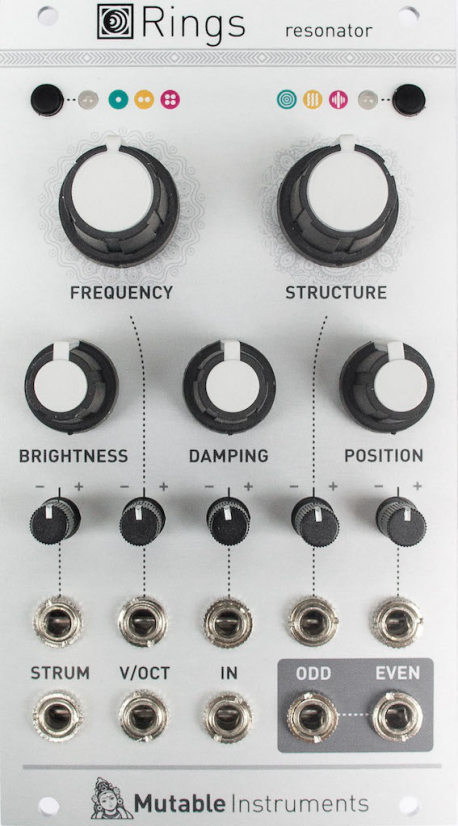
Rings
Mutable Instruments
Regular price
$2,790.00 HKD
Sale
THE PHYSICAL MODELLING BUILDING BLOCK
Rings brings physical modelling synthesis to your Eurorack system, from a more modular angle than Braids’ models or Elements.
Instead of trying to be a complete instrument, Rings focuses on the key ingredient, the resonator, ready to be excited by envelope clicks, trigger pulses, granular noise or any other audio source produced by the rest of your system.
Three families of vibrating structures are simulated by the module, with CV control over their parameters:
- Strings, membranes and tubes as modelled by Elements’ resonator section (modal synthesis).
- Strings coupled together and vibrating in sympathy, with controllable intervals between them.
- Strings with a variable amount of inharmonicity.
Rings can be configured so that each new note is played on its own virtual string, while the previously played note(s) still decay(s). This unique take on polyphony allows the module to play strummed chords.
Three resonator models
- Modal resonator, as used in Elements.
- Sympathetic strings, modelled by a network of comb filters.
- String with non-linearity/dispersion (comb filter with multimode filter and non-linearities in the loop).
All resonator models can be used polyphonically, with 1, 2 or 4 polyphony voices.
Voltage-controlled resonator
Each model provides a unified set of parameters, all voltage controlled, with an attenuverter:
- Structure. With the modal and non-linear string models, controls the inharmonicity of the spectrum (which directly impacts the perceived “material”). With the sympathetic strings model, controls the intervals between strings.
- Brightness. Specifies the brightness and richness of the spectrum.
- Damping. Controls the damping rate of the sound, from 100ms to 10s.
- Position. Specifies at which point the structure is excited.
Easy to patch
- Audio input accepting modular level signals, up to 16 Vpp.
- Two audio outputs, either splitting odd/even partials in monophonic mode, or even/odd notes in polyphonic mode.
- Voltage change detector on the V/O input, allocating a new polyphony voice each time a different note is played.
- Internal exciter triggered by the STRUM input (filtered pulse or noise burst), allowing the module to be used without an external excitation source.
Specifications
- Trigger input: 100k impedance, 0.6V threshold.
- CV inputs: 100k impedance, +/- 8V, 12-bit 2kHz.
- Audio I/O: 16-bit, 48kHz.
- Internal processing: 32-bit floating point.
